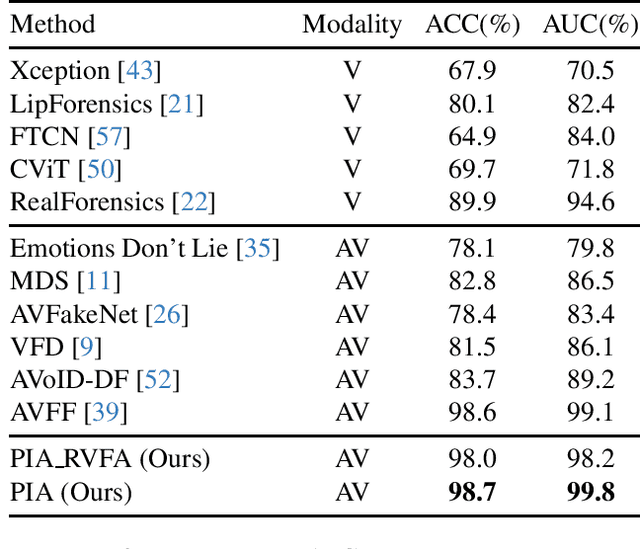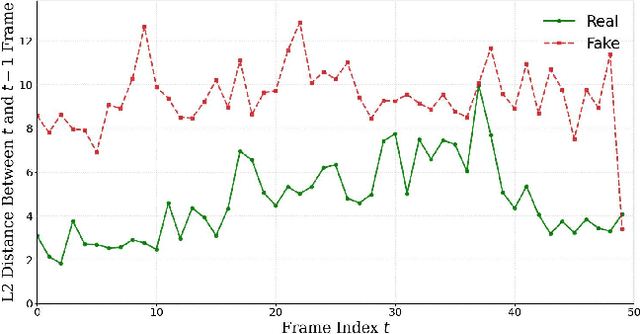Siwei Lyu
DeepfakeBench-MM: A Comprehensive Benchmark for Multimodal Deepfake Detection
Oct 26, 2025Abstract:The misuse of advanced generative AI models has resulted in the widespread proliferation of falsified data, particularly forged human-centric audiovisual content, which poses substantial societal risks (e.g., financial fraud and social instability). In response to this growing threat, several works have preliminarily explored countermeasures. However, the lack of sufficient and diverse training data, along with the absence of a standardized benchmark, hinder deeper exploration. To address this challenge, we first build Mega-MMDF, a large-scale, diverse, and high-quality dataset for multimodal deepfake detection. Specifically, we employ 21 forgery pipelines through the combination of 10 audio forgery methods, 12 visual forgery methods, and 6 audio-driven face reenactment methods. Mega-MMDF currently contains 0.1 million real samples and 1.1 million forged samples, making it one of the largest and most diverse multimodal deepfake datasets, with plans for continuous expansion. Building on it, we present DeepfakeBench-MM, the first unified benchmark for multimodal deepfake detection. It establishes standardized protocols across the entire detection pipeline and serves as a versatile platform for evaluating existing methods as well as exploring novel approaches. DeepfakeBench-MM currently supports 5 datasets and 11 multimodal deepfake detectors. Furthermore, our comprehensive evaluations and in-depth analyses uncover several key findings from multiple perspectives (e.g., augmentation, stacked forgery). We believe that DeepfakeBench-MM, together with our large-scale Mega-MMDF, will serve as foundational infrastructures for advancing multimodal deepfake detection.
PIA: Deepfake Detection Using Phoneme-Temporal and Identity-Dynamic Analysis
Oct 16, 2025



Abstract:The rise of manipulated media has made deepfakes a particularly insidious threat, involving various generative manipulations such as lip-sync modifications, face-swaps, and avatar-driven facial synthesis. Conventional detection methods, which predominantly depend on manually designed phoneme-viseme alignment thresholds, fundamental frame-level consistency checks, or a unimodal detection strategy, inadequately identify modern-day deepfakes generated by advanced generative models such as GANs, diffusion models, and neural rendering techniques. These advanced techniques generate nearly perfect individual frames yet inadvertently create minor temporal discrepancies frequently overlooked by traditional detectors. We present a novel multimodal audio-visual framework, Phoneme-Temporal and Identity-Dynamic Analysis(PIA), incorporating language, dynamic face motion, and facial identification cues to address these limitations. We utilize phoneme sequences, lip geometry data, and advanced facial identity embeddings. This integrated method significantly improves the detection of subtle deepfake alterations by identifying inconsistencies across multiple complementary modalities. Code is available at https://github.com/skrantidatta/PIA
Celeb-DF++: A Large-scale Challenging Video DeepFake Benchmark for Generalizable Forensics
Jul 24, 2025Abstract:The rapid advancement of AI technologies has significantly increased the diversity of DeepFake videos circulating online, posing a pressing challenge for \textit{generalizable forensics}, \ie, detecting a wide range of unseen DeepFake types using a single model. Addressing this challenge requires datasets that are not only large-scale but also rich in forgery diversity. However, most existing datasets, despite their scale, include only a limited variety of forgery types, making them insufficient for developing generalizable detection methods. Therefore, we build upon our earlier Celeb-DF dataset and introduce {Celeb-DF++}, a new large-scale and challenging video DeepFake benchmark dedicated to the generalizable forensics challenge. Celeb-DF++ covers three commonly encountered forgery scenarios: Face-swap (FS), Face-reenactment (FR), and Talking-face (TF). Each scenario contains a substantial number of high-quality forged videos, generated using a total of 22 various recent DeepFake methods. These methods differ in terms of architectures, generation pipelines, and targeted facial regions, covering the most prevalent DeepFake cases witnessed in the wild. We also introduce evaluation protocols for measuring the generalizability of 24 recent detection methods, highlighting the limitations of existing detection methods and the difficulty of our new dataset.
Geometric Regularity in Deterministic Sampling of Diffusion-based Generative Models
Jun 11, 2025Abstract:Diffusion-based generative models employ stochastic differential equations (SDEs) and their equivalent probability flow ordinary differential equations (ODEs) to establish a smooth transformation between complex high-dimensional data distributions and tractable prior distributions. In this paper, we reveal a striking geometric regularity in the deterministic sampling dynamics: each simulated sampling trajectory lies within an extremely low-dimensional subspace, and all trajectories exhibit an almost identical ''boomerang'' shape, regardless of the model architecture, applied conditions, or generated content. We characterize several intriguing properties of these trajectories, particularly under closed-form solutions based on kernel-estimated data modeling. We also demonstrate a practical application of the discovered trajectory regularity by proposing a dynamic programming-based scheme to better align the sampling time schedule with the underlying trajectory structure. This simple strategy requires minimal modification to existing ODE-based numerical solvers, incurs negligible computational overhead, and achieves superior image generation performance, especially in regions with only $5 \sim 10$ function evaluations.
Forensic deepfake audio detection using segmental speech features
May 20, 2025Abstract:This study explores the potential of using acoustic features of segmental speech sounds to detect deepfake audio. These features are highly interpretable because of their close relationship with human articulatory processes and are expected to be more difficult for deepfake models to replicate. The results demonstrate that certain segmental features commonly used in forensic voice comparison are effective in identifying deep-fakes, whereas some global features provide little value. These findings underscore the need to approach audio deepfake detection differently for forensic voice comparison and offer a new perspective on leveraging segmental features for this purpose.
Tamper-evident Image using JPEG Fixed Points
Apr 24, 2025Abstract:An intriguing phenomenon about JPEG compression has been observed since two decades ago- after repeating JPEG compression and decompression, it leads to a stable image that does not change anymore, which is a fixed point. In this work, we prove the existence of fixed points in the essential JPEG procedures. We analyze JPEG compression and decompression processes, revealing the existence of fixed points that can be reached within a few iterations. These fixed points are diverse and preserve the image's visual quality, ensuring minimal distortion. This result is used to develop a method to create a tamper-evident image from the original authentic image, which can expose tampering operations by showing deviations from the fixed point image.
Detecting Lip-Syncing Deepfakes: Vision Temporal Transformer for Analyzing Mouth Inconsistencies
Apr 02, 2025Abstract:Deepfakes are AI-generated media in which the original content is digitally altered to create convincing but manipulated images, videos, or audio. Among the various types of deepfakes, lip-syncing deepfakes are one of the most challenging deepfakes to detect. In these videos, a person's lip movements are synthesized to match altered or entirely new audio using AI models. Therefore, unlike other types of deepfakes, the artifacts in lip-syncing deepfakes are confined to the mouth region, making them more subtle and, thus harder to discern. In this paper, we propose LIPINC-V2, a novel detection framework that leverages a combination of vision temporal transformer with multihead cross-attention to detect lip-syncing deepfakes by identifying spatiotemporal inconsistencies in the mouth region. These inconsistencies appear across adjacent frames and persist throughout the video. Our model can successfully capture both short-term and long-term variations in mouth movement, enhancing its ability to detect these inconsistencies. Additionally, we created a new lip-syncing deepfake dataset, LipSyncTIMIT, which was generated using five state-of-the-art lip-syncing models to simulate real-world scenarios. Extensive experiments on our proposed LipSyncTIMIT dataset and two other benchmark deepfake datasets demonstrate that our model achieves state-of-the-art performance. The code and the dataset are available at https://github.com/skrantidatta/LIPINC-V2 .
HOIGPT: Learning Long Sequence Hand-Object Interaction with Language Models
Mar 24, 2025



Abstract:We introduce HOIGPT, a token-based generative method that unifies 3D hand-object interactions (HOI) perception and generation, offering the first comprehensive solution for captioning and generating high-quality 3D HOI sequences from a diverse range of conditional signals (\eg text, objects, partial sequences). At its core, HOIGPT utilizes a large language model to predict the bidrectional transformation between HOI sequences and natural language descriptions. Given text inputs, HOIGPT generates a sequence of hand and object meshes; given (partial) HOI sequences, HOIGPT generates text descriptions and completes the sequences. To facilitate HOI understanding with a large language model, this paper introduces two key innovations: (1) a novel physically grounded HOI tokenizer, the hand-object decomposed VQ-VAE, for discretizing HOI sequences, and (2) a motion-aware language model trained to process and generate both text and HOI tokens. Extensive experiments demonstrate that HOIGPT sets new state-of-the-art performance on both text generation (+2.01% R Precision) and HOI generation (-2.56 FID) across multiple tasks and benchmarks.
Your Text Encoder Can Be An Object-Level Watermarking Controller
Mar 15, 2025Abstract:Invisible watermarking of AI-generated images can help with copyright protection, enabling detection and identification of AI-generated media. In this work, we present a novel approach to watermark images of T2I Latent Diffusion Models (LDMs). By only fine-tuning text token embeddings $W_*$, we enable watermarking in selected objects or parts of the image, offering greater flexibility compared to traditional full-image watermarking. Our method leverages the text encoder's compatibility across various LDMs, allowing plug-and-play integration for different LDMs. Moreover, introducing the watermark early in the encoding stage improves robustness to adversarial perturbations in later stages of the pipeline. Our approach achieves $99\%$ bit accuracy ($48$ bits) with a $10^5 \times$ reduction in model parameters, enabling efficient watermarking.
Recent Advances on Generalizable Diffusion-generated Image Detection
Feb 27, 2025Abstract:The rise of diffusion models has significantly improved the fidelity and diversity of generated images. With numerous benefits, these advancements also introduce new risks. Diffusion models can be exploited to create high-quality Deepfake images, which poses challenges for image authenticity verification. In recent years, research on generalizable diffusion-generated image detection has grown rapidly. However, a comprehensive review of this topic is still lacking. To bridge this gap, we present a systematic survey of recent advances and classify them into two main categories: (1) data-driven detection and (2) feature-driven detection. Existing detection methods are further classified into six fine-grained categories based on their underlying principles. Finally, we identify several open challenges and envision some future directions, with the hope of inspiring more research work on this important topic. Reviewed works in this survey can be found at https://github.com/zju-pi/Awesome-Diffusion-generated-Image-Detection.
 Add to Chrome
Add to Chrome Add to Firefox
Add to Firefox Add to Edge
Add to Edge